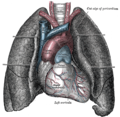Ascending aorta
This article needs additional citations for verification. (September 2014) |
| Ascending aorta | |
|---|---|
inferior vena cava and coronary sinus | |
| Supplies | The entire body, with exception of the respiratory zone of the lung |
| Identifiers | |
| Latin | aorta ascendens, pars ascendens aortae |
| TA98 | A12.2.03.001 |
| TA2 | 4176 |
| FMA | 3736 |
| Anatomical terminology] | |
The ascending aorta (AAo)
Structure
It passes obliquely upward, forward, and to the right, in the direction of the heart's axis, as high as the upper border of the second right
Components
The aortic root is the portion of the aorta beginning at the aortic annulus and extending to the sinotubular junction. It is sometimes regarded as a part of the ascending aorta,[2] and sometimes regarded as a separate entity from the rest of the ascending aorta.[3]
Between each commissure of the
The sinotubular junction is the point in the ascending aorta where the aortic sinuses end and the aorta becomes a tubular structure.
Size
A
Relations
At the union of the ascending aorta with the aortic arch the caliber of the vessel is increased, owing to a bulging of its right wall.
This dilatation is termed the bulb of the aorta, and on transverse section presents a somewhat oval figure.
The ascending aorta is contained within the pericardium, and is enclosed in a tube of the serous pericardium, common to it and the pulmonary artery.
The ascending aorta is covered at its commencement by the trunk of the
On the right side, it is in relation with the
Branches
The only branches of the ascending aorta are the two
Clinical significance
Porcelain aorta is extensive
The ascending aorta segment is of significant due to its susceptibility to aortic dissection, two times more than in the descending aorta. Early detection of dissection is critical because it allows for prompt intervention to prevent potentially life-threatening complications.[7]
Diagnostics
Diagnostic methods such as
Images
-
Front view of heart and lungs.
-
The arch of the aorta, and its branches.
-
Fetal ascending aorta
-
Ascending aorta
-
Ascending aorta
-
Ascending aorta
-
Ascending aorta
-
Ascending aorta
-
Ascending aorta
-
Ascending aorta
References
![]() This article incorporates text in the public domain from page 545 of the 20th edition of Gray's Anatomy (1918)
This article incorporates text in the public domain from page 545 of the 20th edition of Gray's Anatomy (1918)
- ISBN 0-397-54589-4.
- PMID 16908722.
- PMID 23701088.
- ^ Bret P Nelson (October 1, 2015). "Thoracic Aneurysm". Medscape. Retrieved April 16, 2017.
- PMID 19356429.
- ^ PMID 24773854.
- ^ "Aortic Dissection: Causes, Symptoms & Treatments". Cleveland Clinic. Retrieved March 12, 2024.










